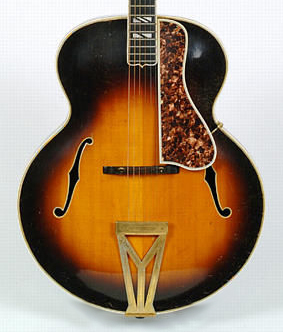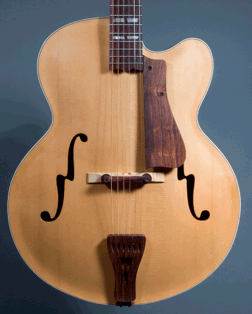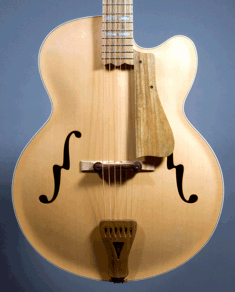

For my first archtop model, called Skylark, I wanted to build a large acoustic guitar with a big, warm and clear voice. My inspiration was a 1936 Gibson Super 400 that I acquired many years ago (like the one with the white background, left). It had a cracked X-brace, a collapsed top, a loose back, a warped pick guard, and a lot of wear on the neck and frets. Once I had restored it, I discovered a warmth of sound unlike anything I had heard from other archtops.
My prototype (grey background, below left) was designed to have that warmth of sound, and improve upon it. There are some features from the 1936 Super 400 that I kept, and some things that I wanted to change. Nominally an 18 inch guitar (the widest dimension, across the lower bouts), the 1936 Super 400 has upper bouts that are no larger than a modern L-5, about 12 5/8 inches. This makes it easier to hold than most 18 inch guitars. In 1937, Gibson increased the width of the Super 400 at the upper bouts by about an inch, and all subsequent Super 400s have had a bloated outline that is quite an armful for most people. Skylark has the body length and upper and lower bout dimensions of a 1936 Super 400. The waist is slightly wider, by about 1/8 inch overall, and I moved the waist and hips down just a bit. I think the 1936 Super 400 looks just a bit pinched and uptight, like a Victorian lady in a corset, and I wanted a more relaxed outline.
My prototype (grey background, below left) was designed to have that warmth of sound, and improve upon it. There are some features from the 1936 Super 400 that I kept, and some things that I wanted to change. Nominally an 18 inch guitar (the widest dimension, across the lower bouts), the 1936 Super 400 has upper bouts that are no larger than a modern L-5, about 12 5/8 inches. This makes it easier to hold than most 18 inch guitars. In 1937, Gibson increased the width of the Super 400 at the upper bouts by about an inch, and all subsequent Super 400s have had a bloated outline that is quite an armful for most people. Skylark has the body length and upper and lower bout dimensions of a 1936 Super 400. The waist is slightly wider, by about 1/8 inch overall, and I moved the waist and hips down just a bit. I think the 1936 Super 400 looks just a bit pinched and uptight, like a Victorian lady in a corset, and I wanted a more relaxed outline.
A nice feature of the ‘36 Super 400 outline is the distinctive sloped shoulders. The upper bouts curve continuously from the center seam where the sides meet under the neck heel. Even the area right where the neck dovetails into the neck block is not completely flat. The 1936 Super 400 sloped shoulders are more graceful looking than the later Gibson guitars, which have a broad shouldered flat profile in this area, and they also contribute to making the guitar easier to hold.
Since completing my prototype 18” guitar in 2008, I have designed 17” and 16” models.
Since completing my prototype 18” guitar in 2008, I have designed 17” and 16” models.


My 17” model has the same general dimensions as a modern Gibson L5, but it has sloped shoulders, a slightly deeper cutaway, and a bit more relaxed waist.
My 16” model has the same general dimensions as a 1920s Gibson L5, or a Gibson ES-175, but it has a Venetian cutaway, and is a little fuller in the waist.
